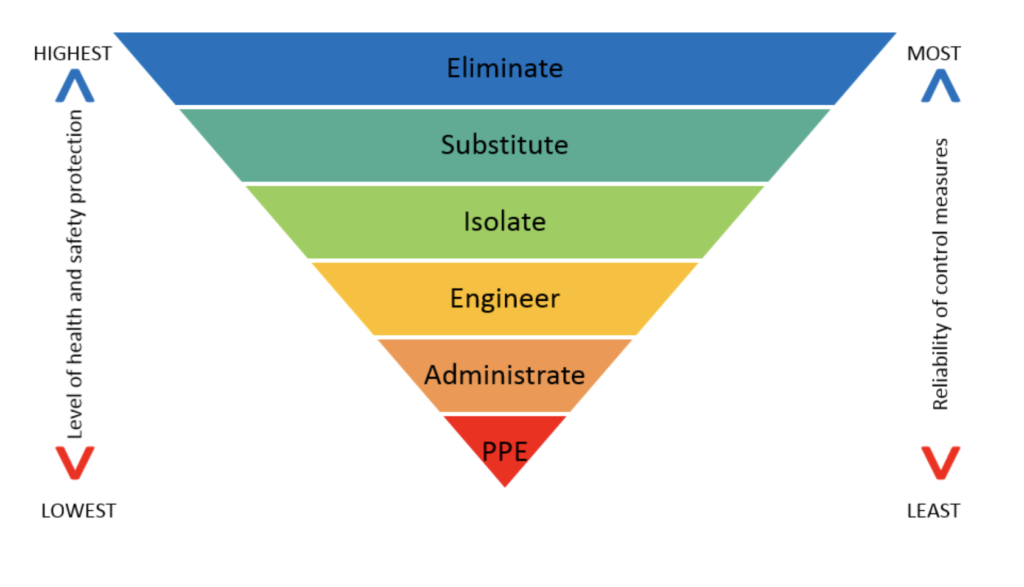Workplace cleanliness and hygiene
Thanks for entering your email, you can read your factsheet here.
Across all industries and workplaces, over two-million workers in unions across Australia continue to negotiate higher pay to ensure all members get a fair wage for a fair day’s work. Join your union today and make it happen.Coronavirus (COVID-19): Workplace cleanliness and hygiene
COVID–19 is a health and safety risk. Employers and other duty holders (such as property managers/ owners) have obligations to ensure the health and safety of workers and others. They must have a plan on what will be done to protect and support workers, and health and safety representatives (HSRs) must be consulted on this plan.
As with any other risk, employers/PCBUs must consider how to implement the most reliable ways to prevent harm. This should involve the application of the hierarchy of controls (refer to the diagram below). The hierarchy of controls requires priority to be placed on the elimination of hazards, or isolation of people from exposure to harm where possible. Lower order administrative controls which focus on individual worker behaviours or the application of PPE should only be applied where higher-order controls are not possible or effective.
Hierarchy of controls

Applying the hierarchy of controls to COVID-19 may require multiple measures to be implemented in a workplace.
The best risk control measure for preventing exposure to COVID-19 is physical distancing and fresh clean air, together with other measures, such as cleaning and improved hygiene.
The mechanical process of cleaning removes dirt and grime. This needs to be done with a detergent solution (as per the manufacturer’s instructions). Detergent-impregnated wipes may be used but should not be used as a replacement for the mechanical cleaning process.
Following cleaning with detergents, disinfectants are used to kill the virus. Disinfectants may not kill the virus if the surface has not been cleaned with detergent first.
Where to clean
This information is to assist workers and HSRs when consulting with employers/PCBUs about what areas need to be cleaned.
Routinely clean frequently touched hard surfaces – these are a few examples to prompt thinking about which surfaces are most commonly touched in your workplace:
- door handles, handrails, trolleys
- light switches
- bench, desk and tabletops
- frequently touched handles on machinery, tools and equipment
- steering wheels, control panels
- washing facilities, taps
Workplaces should clean surfaces at least daily or in between changes of shift or when new workers are entering other areas or using shared equipment or furniture; once clean, surfaces should be disinfected regularly. The disinfectant used should be one for which the manufacturer claims antiviral activity, meaning it can kill the virus (such as chlorine-based disinfectants). At least 10 minutes contact time is required to kill viruses.
Cleaning of facilities, such as tabletops and meal areas should occur after meal and break times. Areas where there is lots of pedestrian traffic, or places where members of the public attend, should be cleaned more regularly.
For many hard surfaces such as tool handles, the use of alcohol-based wipes before and after use will decrease the chances of contamination.
Alcohol-based hand sanitiser stations should be available throughout the site and workers should be given time and access to handwashing facilities. This encourages good hand hygiene.
Hand hygiene
Soap and water are the most effective method of removing the virus from our hands. The soap breaks the outer layer of the virus. Wash for 20 seconds. Alcohol-based hand sanitiser can be used at other times (e.g. when hands have been contaminated from contact with surfaces). Cleaning hands also helps to reduce environmental contamination.
Personal protective equipment
Depending upon the work this may include eye protection, respiratory protection, clothing, gloves etc.
Protective equipment must be cleaned between uses and must not be shared. If it is to be reused proper cleaning is essential.
Remember: cleaning is one of the control measures but it must be accompanied by measures that implement good ventilation and physical distancing.
Visit Safe Work Australia for more information on COVID-19 health and safety measures, and get in touch with your union if you have concerns.
Enter your email to access our expert workplace information
Almost two million union members have contributed to us providing this free workplace factsheet. Because you’ve read a few of our factsheets, we’re asking for your email address to keep reading. This is so we can keep you updated with the latest news and workplace advice.
Don’t worry: our factsheets will always remain free, thanks to the solidarity of the union movement.






